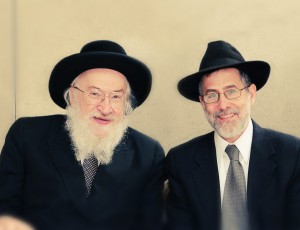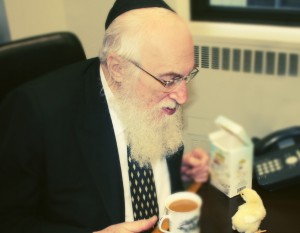A Portrait of Greatness
By Menachem Genack
The petirah of Rabbi Chaim Yisroel Belsky was a tragedy for the Jewish world at large as well as for our close-knit OU community. We at OU Kosher had the privilege of having Rabbi Belsky work closely with us over the years, and we had the opportunity to experience first-hand his exceptional gifts.
Anyone who interacted with Rabbi Belsky was immediately impressed by two qualities. First, there was his astounding knowledge. Aside from his total command of Torah She’bichtav (the Written Torah) and Torah She’be’al Peh (the Oral Torah), he was an expert in mathematics and the sciences, including astronomy, zoology, anatomy, botany, physics and other branches of science, all of which was self-taught. The second quality that was immediately apparent about Rabbi Belsky was his winning smile and listening ear.

Rabbi Chaim Yisroel Belsky, senior halachic consultant, OU Kosher, with Rabbi Menachem Genack, CEO, OU Kosher. Photo: Shulim Goldring
Rabbi Belsky’s vast scientific knowledge was often useful in analyzing halachic issues and was especially helpful concerning kashrut issues that OU Kosher had to deal with. Not only was his expertise in animal anatomy invaluable in determining difficult kashrut questions, but his technical skill and mechanical aptitude were critical in analyzing kashrut problems concerning the machinery and equipment used in plants that produce and process OU-certified products. Plant managers were often amazed by Rabbi Belsky’s grasp of the intricacies of the machinery, which often exceeded their own knowledge, and were also struck by his courteous and dignified demeanor. One non-Jewish plant manager sent the following message to the OU shortly after Rabbi Belsky’s petirah: “Just found out about his passing. He had a profound impact on me with his wisdom to analyze and solve problems. May his memory be eternal.”
Let me share with you a few examples of Rabbi Belskly’s remarkable scientific knowledge and how he applied it to kashrut issues. Some years ago, the OU was approached to certify the shechitah of deer for the purpose of obtaining kosher venison. One halachic concern was whether it was permissible to perform nikkur on deer. Nikkur is the process of removing the prohibited sciatic nerve (gid hanasheh) and the forbidden fats (chelev) from the hindquarters of an animal. There is a prevalent minhag, generally followed in the United States, that even though it may be physically possible to perform nikkur on an animal, we generally do not perform it, and simply refrain from consuming the hindquarters of animals. With regard to deer, were nikkur not permitted, the desired cuts of meat would not be available. The prohibition of gid hanasheh applies to deer, but not the prohibition of chelev. So the halachic question that needed to be resolved was whether the minhag of not performing nikkur applied to deer. Rabbi Belsky consulted with Rabbi Yosef Shalom Elyashiv, zt”l, who stated that the minhag of not preforming nikkur was due to the difficulty in properly removing all of the chelev. Thus, since the prohibition of chelev does not apply to deer, the minhag of not performing nikkur did not apply either; hence, nikkur could be performed on the deer. The next challenge was a practical one. The nikkur, the removal of the gid hanasheh, had to be done in a way that would not ruin the hindquarters and the desired cuts of meat could be obtained. To resolve this, Rabbi Belsky consulted with various surgeons. Using special scalpels, he performed the nikkur on the deer. During the summer months, Rabbi Belsky would bring boys from Camp Agudah to a plant in Goshen, New York, to illustrate how to perform nikkur on a deer.
 Rabbi Belsky was famous for his public demonstrations in which he would dissect an animal and explain the different treifot, infirmities and defects in the limbs and organs of the animal which would render it non-kosher. I recall one demonstration where Rabbi Belsky gave instructions ahead of time to have the front portion of an animal brought to the program. He had prepared a shiur on the various treifot found in that part of the animal. At the demonstration, when we unwrapped the large package prepared by the butcher, lo and behold, it became clear that there was a mistake: the butcher had sent the hindquarters of the animal rather than the front portion. Without missing a beat, Rabbi Belsky said, “Well, there is much we can learn about kashrus from the hindquarters of an animal”; he then proceeded to give an expert shiur on the topic.1
Rabbi Belsky was famous for his public demonstrations in which he would dissect an animal and explain the different treifot, infirmities and defects in the limbs and organs of the animal which would render it non-kosher. I recall one demonstration where Rabbi Belsky gave instructions ahead of time to have the front portion of an animal brought to the program. He had prepared a shiur on the various treifot found in that part of the animal. At the demonstration, when we unwrapped the large package prepared by the butcher, lo and behold, it became clear that there was a mistake: the butcher had sent the hindquarters of the animal rather than the front portion. Without missing a beat, Rabbi Belsky said, “Well, there is much we can learn about kashrus from the hindquarters of an animal”; he then proceeded to give an expert shiur on the topic.1
The foundation of all of Rabbi Belsky’s qualities was ahavah, a profound and enduring love, consisting of ahavat Hashem, ahavat haTorah and ahavat haberiyot. Maimonides, in the second chapter of Hilchot Yesodei HaTorah, states that the way one achieves ahavat Hashem, love of the Almighty, is by looking at the grandeur of nature and the design in the universe, which brings love of Hashem to the sensitive heart. This theme certainly describes Rav Belsky. He used his amazing aptitude for science and understanding of the natural world to enhance his appreciation of God’s handiwork.
Rabbi Belsky’s ahavat haTorah was boundless. He used his scientific knowledge as a handmaiden to Torah, which served to broaden his Torah knowledge and enhance his lomdut. In addition to his mastery of the world of Torah, he also took the greatest pleasure in teaching and transmitting Torah. Always accompanied at the OU by his talmidim, his concern for his students’ learning, for the pedagogic process, for maximizing the way the students would learn both the substantive knowledge and the method of analysis, was legendary.
Rabbi Belsky was renowned for his ahavat haberiyot, concern for his fellow human being. He was known for caring about and fighting for those who were most dejected and most in need of help. And he would always take action on their behalf. Whenever he was aware of an agunah situation, he would take the lead in trying to help. With the wave of Jewish immigration from the Former Soviet Union to the US, Rabbi Belsky learned Russian on his own in order to be able to communicate with these souls who had been cut off from their religion for

Rabbi Belsky in his office at OU national headquarters in Manhattan, evaluating the kashrut of chicks vaccinated in the egg.
so long. He often took action to help others in need at risk to himself and his own reputation, yet he did not hesitate to do what he felt was needed. If publicly humiliated, he did not respond. The Gemara in Gittin (36b) states: “Those who are insulted but do not insult others, those who are shamed but do not respond . . . about such people, Scripture says, ‘ve’ohavav ke’tzeit hashemesh bi’gevurato, but they that love Him be as the sun when he goes forth in his might’” (Sefer Shoftim 5:31). Rabbi Ahron Soloveichik, quoting Rabbi Avraham Yitzchak HaCohen Kook, asked: how does the Gemara derive that the verse is referring to those who are insulted but do not respond? He answers with a question: Why does the verse state that the sun is most potent when it first rises? Doesn’t the sun’s strength peak at midday? The verse, he says, is coming to teach us that when the sun first rises, and restricts its own power by emitting its heat gradually, that is precisely when it exhibits its greatest “strength”—its capacity for self-discipline and self-restraint. Similarly, those who are insulted and do not respond, those who have the ability to respond but deliberately hold back, are displaying genuine strength, the attribute of gevurah. Rabbi Belsky exercised this type of discipline, the self-control to not retaliate in kind when humiliated, and this discipline was also a manifestation of his characteristic of ahavah, great love for the other person.
Rabbi Belsky was a man of great humility and of great strength; of great kindness but also great tenacity; of unbending principle but also deep love. He was a man of steel cloaked in the most delicate, gentle velvet.
Yehi zichro baruch.
Note
1. This anecdote brings to mind Abraham Lincoln’s reaction to correspondence he received from one of his less competent generals, Joseph Hooker. Hooker would sign his dispatches to Lincoln, “Joseph Hooker, his headquarters are in the saddle.” Lincoln remarked that the trouble with Hooker was that “his headquarters was where his hindquarters ought to be.”
Rabbi Menachem Genack is CEO of OU Kosher.
Listen to Rabbi Menachem Genack discuss his memories of Rabbi Belsky at ou.org/life/inspiration/savitsky_genack
